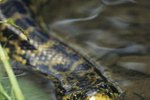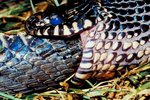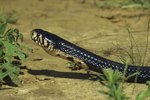
The world is full of green snakes. Some are bright green, some are dark green and some can be called green only if you include "olive drab" in that category. Color is no indicator to a snake's personality or capability, so it's important to learn to tell one green snake from another.
North America
North America has the rough and the smooth green snake. Of these, the rough is the brighter green as an adult and its scales are angled, making it feel slightly rough to the touch. Both are nonvenomous, but the rough has the calmer disposition of the two and does better in captivity. Both are insect eaters. The rough green snake is common in the eastern part of the continent from New England to Florida, while the smooth is found in the Midwestern states and farther north into Canada.
The green watersnake of the South is more likely to be olive drab, brown or even reddish, and juveniles have dark markings or bars that can cause them to be mistaken for the venomous water moccasin. They live in warm, swampy areas in the South and eat little fish and frogs. If harassed they will bite, but they're not venomous.
South and Central America
A vine snake is any of several species of slender, bright green snake found throughout the tropical rain forests of the world. They are called "vine snakes" because they look like vine stems and often hunt by imitating them, waiting motionless for dinner to come by. One species in South America specializes in lurking next to flowers to snag hummingbirds on the wing. None of these species are venomous. The frog-eating giant parrotsnake is a widespread example of this type of snake.
The emerald tree boa lives in the lowland rain forests of the Amazon. It's a big snake, growing to about 6 feet long, and its vivid green adult coloration is often marked by white patterns down the back. It's a tree dweller and hunts by coiling around a tree branch with its head hanging down, ready to strike from above. It's a nonvenomous constrictor that eats small mammals, birds and frogs.
The green anaconda may be the most massive snake in the world, but it's not the most brightly colored. It's a dark greenish brown with darker blotches and spots, and this coloring helps it hide in swampy tropical water as it hunts anything it can catch, from a capybara to a jaguar. At an average length of 20 feet, it could possibly pose a danger to a human child, but not to an adult—the shoulders would be too wide for the nonvenomous constrictor to swallow.
Asia
The green tree python is very similar to the emerald tree boa, but it lives all the way across the Pacific, on the island of New Guinea and the northern coast of Australia. The two species live in the same kind of habitat and eat the same types of prey. The green tree python has a smaller, finer head than its South American cousin, and its white markings—which can also be blue or yellow—are smaller and more random. It also has a touchier disposition. Like all pythons, it's nonvenomous and a constrictor.
The green cat snake of Thailand and Indochina and the more widespread Asian vine snake are both bright green with a yellow underbelly. The cat snake has a slim, blunt head, while the vine snake has a pointy nose. The cat snake is nonvenomous, while the Asian vine snake is mildly venomous and rear-fanged. Its venom is not dangerous to humans, though, and a bite causes only brief and local discomfort.
Africa
One of the most striking green snakes in southern Africa goes by the pedestrian name of "spotted bush snake." Its intense green color is speckled with black and the irises of its eyes are bright gold to blazing orange, in sharp contrast. It's seen not uncommonly in suburban gardens, but is harmless to humans.
The boomslang, on the other hand, is one of the few snakes whose venom can kill a human, though this is rare. Adult males may be bright green or even a striking bluish green. The eastern green mamba is also venomous, though not nearly as much so as its more notorious cousin the black mamba. This snake is a solid grass-green. It spends nearly all its time in trees and prefers a swift exit when it encounters humans.
Europe
Europe has few snake species, and none of them are green.
References
- Switch Zoo: Rough Green Snake
- BioKids: Smooth Green Snake: Liochlorophis vernalis
- Savannah River Ecology Laboratory: Green Watersnake (Nerodia floridana)
- Animal Diversity Web: Oxybelis fulgidus: Green Vine Snake
- Encyclopedia of Life: Leptophis: Giant Parrotsnake
- FactZoo.com: Emerald Tree Boa—Coiled Green Ambusher
Resources
- Ft. Worth Zoo: Green Tree Python
- Monterrey Bay Aquarium: Asian Vine Snake
- Ecology Asia: Green Cat Snake
- Reptile Knowledge: The Boomslang—Dispholidus typus
- ThinkQuest: Boomslang Snake
- TrekNature: Eastern Green Mamba
- Biodiversity Explorer: Philothamnus semivariegatus
- National Geographic: Green Anaconda, Eunectes murinus
Photo Credits
-
Tom Brakefield/Stockbyte/Getty Images




